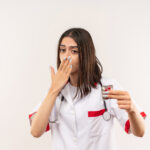
Fast Facts
Common Causes: Hairy tongue syndrome, gastritis, diabetes, COVID-19, oral psoriasis, jaundice
Primary Trigger: Bacterial or yeast buildup on tongue papillae
Symptoms: Yellow discoloration, possible thick greasy coating
Associated Conditions: Poor oral hygiene, smoking, excessive coffee/tea intake, certain medications
Prevention Tips: Regular oral hygiene, quitting smoking, reducing coffee/tea consumption.
There are several reasons why your tongue may appear yellow. While this can be concerning, the most common cause is usually harmless. A yellow tongue is often due to an accumulation of bacteria, debris, or yeast on the papillae—the tiny bumps that cover your tongue.
Besides bacterial or yeast buildup, other causes of yellow tongue include gastritis, jaundice, or diabetes. Understanding these potential causes can help you get the diagnosis and treatment you may need.
What Causes Yellow Tongue?
Several conditions can cause your tongue to turn yellow. The shade of yellow can vary, and besides the color change, you might experience other symptoms depending on the cause.
Hairy Tongue Syndrome
The most common cause of a yellow tongue is hairy tongue syndrome. This condition is characterized by bacterial overgrowth on the papillae. Dead skin, debris, food, and yeast may also accumulate on the tongue. This buildup can cause the tongue to look discolored.
The color of your tongue depends on the substance on the bumps. Hairy tongue syndrome can make the tongue appear yellow, black, brown, white, green, or pink. The condition is named for the “hairy” appearance of the tongue in many cases.
Hairy tongue syndrome is often triggered by poor oral hygiene, drinking large amounts of coffee or tea, smoking, radiation treatment to the head and neck, and prolonged antibiotic use. Certain medications, particularly anticholinergics used to treat cardiovascular disease and urinary incontinence, are also associated with hairy tongue syndrome.
Gastritis
A yellow tongue can be a sign of gastritis, which is inflammation of the stomach lining. This can be caused by several factors, including infection with Helicobacter pylori bacteria and autoimmune issues.
H. pylori infection is particularly linked to a yellow tongue, which may appear with a yellowish, thick, greasy coating. Other symptoms of gastritis include stomach pain, indigestion, bloating, nausea, and vomiting.
Diabetes
Some research suggests a connection between type 2 diabetes and a yellow tongue. A 2018 study in Japan found higher rates of yellow tongue among people with diabetes, particularly older men. A yellow tongue was also more common among those with prediabetes.
Other studies have noted a link between a tongue that appears to have yellow fur and type 2 diabetes. More research is needed to fully understand this connection and whether yellow tongue can be a predictor of diabetes.
COVID-19
A 2022 study found that COVID-19 often causes symptoms on the tongue, including a yellow coating. COVID-19 can also make the tongue look red, purple, or as though it has a white or gray-black coating. The tongue may also appear greasy, rough, spotty, and inflamed.
Researchers believe these changes are due to a hyper-inflammatory response to the infection. Poor oral hygiene and medication side effects may also contribute to a yellow tongue if you have COVID-19.
Oral Psoriasis
Psoriasis, an autoimmune condition that causes skin cells to multiply too quickly, can also affect the mouth, leading to oral psoriasis. This can cause yellow, white, or gray lesions on the tongue, as well as overall oral inflammation, discomfort, and pain.
Jaundice
A less common cause of a yellow tongue is jaundice, which is the yellowing of the skin and the whites of the eyes. Jaundice can also affect the tissues in the mouth, including the tongue.
Jaundice occurs when there is an excess of bilirubin in the bloodstream, often due to liver damage. This excess bilirubin can cause yellowing of the tongue, eyes, and skin. Other symptoms include dark urine, pale stools, and itchy skin.
Treatments for Yellow Tongue
Treatment for a yellow tongue depends on the cause. If an underlying condition like gastritis, diabetes, jaundice, COVID-19, or psoriasis is responsible, treating that condition usually resolves the yellow tongue. If a medication is causing the yellow tongue, switching medications can help.
For hairy tongue syndrome, improving oral hygiene can reduce symptoms. This includes brushing and flossing daily, using a toothbrush or tongue scraper to remove buildup, and keeping up with regular dental appointments.
How to Prevent a Yellow Tongue
Yellow tongue can’t always be prevented, but managing the underlying cause can reduce the chances of it occurring. Your healthcare provider can advise on measures to take based on what’s causing your yellow tongue.
Preventing yellow tongue caused by hairy tongue syndrome involves good oral hygiene practices, such as cleaning your tongue when you brush your teeth. Lifestyle changes, like quitting smoking, drinking less coffee and tea, reducing alcohol consumption, treating dry mouth, and eating soft foods, may also help.
When to See a Healthcare Provider
While most cases of yellow tongue aren’t serious, it’s not considered normal. See a healthcare provider if your tongue turns yellow or becomes discolored. They can determine the cause and whether any treatment is needed.
Ensuring you understand the reasons behind a yellow tongue can help you address the issue effectively and maintain good oral and overall health
A Quick Review
A yellow tongue can be caused by various factors, most commonly due to the buildup of bacteria or yeast on the papillae. Hairy tongue syndrome, gastritis, diabetes, COVID-19, oral psoriasis, and jaundice are notable causes. Treatment depends on the underlying condition but often includes improved oral hygiene and lifestyle changes. Regularly cleaning the tongue and managing health conditions can help prevent recurrence. Consult a healthcare provider if you notice persistent discoloration.











